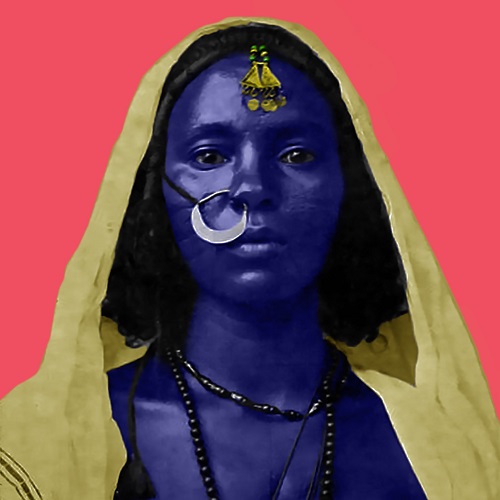Alternative Museum of The Sudan: Exhibition of work by Amado Alfadni, curated by Najlaa El-Ageli, at the Sulger-Buel Gallery in London
Following our ‘Dialogues on the Art of Arab Fashion’ webinar episode on 16 June, our guest, Egyptian-Sudanese artist Amado Alfadni spoke to art and culture advisor Sophie Kazan shedding more light on aspects of this fascinating exhibition, presented here in the third of a three-part series.
KENDAKA I & KENDAKA II - Digital art on paper by Amado Alfadni
Please tell us more about the place of Kendakas in your Alternative Museum of the Sudan.
So,
Kendaka, which means
great woman in ancient Nubian, was a keen warrior who led her army against the Roman empire in a five-year war. We still sing her name in our folk music in Sudan. They have a lot of symbolism; they represent freedom and revolution, and they are the voice bringing Sudan back from religious and colonial oppression, bringing women’s rights back. I use images and postcards of Nubian women to do this. They were represented in the traditional white and my showing colourful clothing is re-establishing their story.
Screenshot from our webinar showing the evolution of the Bint al Sudan perfume bottle and its label
The Bint Al Sudan [girl of Sudan] perfume, which was produced first in Hackney, London and is now produced in Nigeria. Your research into the perfume has revealed an alternative story to that known by people, like you, who had known about it growing up in Egypt?
Yes. It is traditionally used for funerals and weddings throughout West Africa and it has become an iconic and symbolic figure throughout Africa and the Arab world, connecting it to Sudan. It came as a package of incense and henna. My research has shown that the essence for the smell was taken and produced in Hackney. The producer had been asked by native people to make a formula with their own ingredients. It became a traditional, oil-based perfume in Sudan and was strong enough for the hot weather and until today, you can still find it in West Africa and the Arab world. We have stories of people growing up with it as far away as Baghdad – perhaps they travelled to
Al Hajj pilgrimages with it.
Bint al Sudan Revolution label 2019
You have redesigned the label too…
Yes. The original design was taken from a Western photograph of a Sudanese princess… she is bare chested and so with Islamification in the 1990s, we can see that the bottles began to feature a woman in modest clothing who has been made white. This is also an increasingly common theme in Africa and Arab countries where women use whitening creams and we see the idea of beauty transformed here through the labels. And so, my response was that I designed a label which chooses an iconic image of the Sudanese revolution, the Kendaka’s revolution. The Kendaka figure,
Alla’, takes the place of the
Bint Al Sudan on the label. She is a warrior princess and one that can easily be identified by Africans as part of their own, real identity.
***
Read the first part,
Amado Alfadni: The Mahdi Jubba Turban, here.
Read the second part,
Amado Alfadni: The Askari Project, here.
About the Author
Sophie Kazan fell in love with Islamic Art and decoration after visiting the Louvre in Paris. She studied History of Art at L’Ecole du Louvre and has a BA (Hons) in Art and Archaeology of Asia and Africa from SOAS (University of London). Sophie completed her Master's in History of Art from the University of Oxford and a PhD from the School of Museum Studies, University of Leicester. Her research focused on the development of contemporary art and tradition in the United Arab Emirates. Sophie writes about visual art, and she lectures in critical theories and the history of architecture at the University of Falmouth, Cornwall.
Learn more about Sophie’s work on
her website and
Instagram profile.




